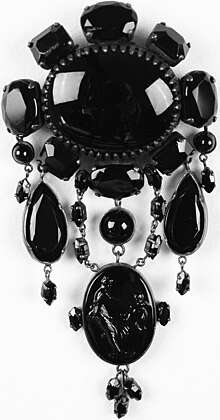jet


Jet - also Jett or coal pitch called - is by humus gel or bitumen -impregnated fossil wood , which is in a transitional stage of the lignite to bituminous coal is located.
Word origin
The German name Gagat is derived from a site near the river and the city of Gagas in Lycia (Turkey). The English and French names ( jet and jais ) are probably also based on this word relationship. It is also known as jet (t) or black amber . The latter designation goes back to the erroneous but persistent assumption of various authors from earlier centuries that Gagat was of the same origin as Bernstein . Equally misleading is the name Olti amber for Gagat from the Turkish province of Erzurum. Other, partly outdated synonyms are Gayet or Jayet , Pechkohle , Schwarzstein , Agtstein , Ambranoir and Witwenstein as well as Succinum nigrum and Gagatit .
Origin and properties
Gagat is often referred to as sapropelite . In fact, sapropelites are generally petrified digested sludge sediments that have formed in shallow waters, while gagat is the result of wood that has been lithified in the absence of air (in the digested sludge) , which often comes from a large Jurassic pancake ( Araucaria ). The density of Gagat is 1.23 g / cm³. Due to its chemical composition (C, O, H, N) it belongs to the coal rocks. The Mohs' hardness of the amorphous material is between 2.5 and 4, its break is shell-like, the line color brown to black. Like amber, Gagat also charges electrically when rubbed. Because of its velvety greasy sheen, which can be increased by polishing , Gagat is also used as a gemstone.
history
Because of its luster and ease of carving, gagat was used as jewelry in prehistoric times . The small, stylized female figures of the Magdalenian are also pendants. On Petersfels they were Venus statuettes made of jet in large numbers. It was not until 1990 that almost identical Gagat figurines were discovered in the Monruz site on Lake Neuchâtel in Switzerland, which was dated the same time. Gagat pendants with amber slides are known. The Romans made jewelry, spinning tools ( spindle whorls and distaffs ) and amulets from Gagat. From the Middle Ages , mourning jewelry and rosaries were made from them in Europe .
Pliny the Elder attributed healing properties to the gagat. In this way he protects against the evil eye , drives away snakes, cures hysteria and toothache, conquers epilepsy and helps to establish virginity. In gemstone therapy , Gagat is considered a mourning stone .
At the end of the 19th century, at the heyday of Jett fashion, when the occurrence became rarer, ebonite , a hard rubber, was also used as a gagat substitute. The main deposit at that time was on the English north coast near the port city of Whitby . There are other occurrences in the Spanish region of Asturias ( Villaviciosa ), southern France , Austria ( Gams near Hieflau and in the Reichraminger Hintergebirge - Am Sandl) and in Württemberg .
A large part of the Spanish finds went to the guild of Gagat carvers of Santiago de Compostela ( Cofradía de los azabacheros de Santiago ), which, in addition to jewelry and devotional items , made pilgrim signs and souvenirs in the form of scallops or the so-called Santiago-Fica , which were used as a defense against the evil eye was made. The concentration of the Gagat carvers around one place at the Cathedral of Santiago de Compostela has been preserved to this day with Plaza de Azabache or Azabachería (Gagat Square) in its name.
Imitations
Since gagat resembles the rare onyx , it is sometimes used as a raw material for imitations of the same. In the meantime, however, colored agate and schörl are increasingly being used as an imitation base for onyx and also for gagat, as it is very sensitive to damage (especially scratches) due to its low Mohs hardness of 2.5 to 4.
Can be confused and imitates jet with anthracite coal , asphalt , Kännel- or sapropel coal and colored glass , hard rubber and plastic .
literature
- Wilhelmine Hagen : Imperial Gagat work from Rhenish Germania . In: Bonner Jahrbücher . Booklet 142. Mainz 1937, DNB 570346231 , p. 77-144 .
- Walter Schumann: Precious stones and gemstones . 13th edition. BLV, Munich 2002, ISBN 3-405-16332-3 , p. 252 .
- Bernhard Bruder: Beautified stones . Neue Erde, Saarbrücken 1998, ISBN 3-89060-025-5 , p. 67, 68 .
- Manfred Weller, Charles Wert: The Fossil Hydrocarbon Jet. In: The Geosciences. 11, 9, 1993, pp. 319-325. doi: 10.2312 / geosciences. 1993.11.319
- Bernhard Gruber: The "black amber" - Gagat. In: Upper Austrian GEO news. Contributions to the geology, mineralogy and paleontology of Upper Austria. 14: 37-41. 1999 ( PDF; 5.82 MB)
Web links
- Museo de Azabache (Gagat Museum Santiago, Spanish, Galician, English)
- Jet. In: Mineralienatlas Lexikon. Stefan Schorn u. a., accessed on August 31, 2015 .
Individual evidence
- ^ Jett - Duden , Bibliographisches Institut ; 2016
- ↑ a b Gagat - Duden , Bibliographisches Institut ; 2016
- ^ Among other things, T. Bartholin: Acta medica & philosophica hafniensia 1673. Copenhagen 1675.
- ↑ Jet. In: The great art lexicon by PW Hartmann. Retrieved August 31, 2015 .
- ↑ HU Kasper: The Romanian amber. In: Amber - Tears of the Gods. Bochum 1996, ISBN 3-921533-57-0 , pp. 357-362.
- ↑ Gerd Albrecht, Andrea Hahn: Reindeer hunters in the Brudertal. The Upper Palaeolithic sites around the Petersfels and the municipal museum Engen im Hegau (= guide to archaeological monuments in Baden-Württemberg . Volume 15 ). S. 82 (with photo).
- ↑ Fica. In: The great art lexicon by PW Hartmann. Retrieved August 31, 2015 .
